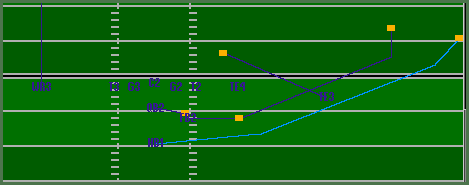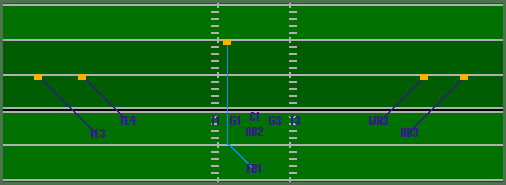
The Running Game
Darrell Young - CSFL London Fog
Okay, here is the first installment in what I hope will be a regular series of coaching tips by the star owners of the CSFL. Each aspect of the game is important, and certain coaches seem to have more expertise in unique areas. My personal strong suit is running the football, so that's what I get to talk about!
The first thing is the players and how they get utilized. I always have 6 RB, 3 HB and 3 FB on my active roster (see Fig. 1). HB1 runs outside (Zandofsky in the CSFL), and gains most of my rushing yards. FB1 runs inside as a power runner (Capper). HB2 is the RB pass catcher and primary punt and kick returner (Delpino). HB3 is the highest SP guy, and serves as a decoy to draw away m2m defense from the three ball handlers, HB1, FB1 and HB2, while also serving as the other kickoff returner (Brothers). FB2 and FB3 (Bell and Hall) serve as the backfield blockers on pass plays or lead blockers on sweeps. All my plays are designed around this rotation, for two simple reasons...it uses each player to his best ability, and keeps everyone fresh because none of them are EVER used in any other role.
Figure 1 - Roster Usage

As for plays, the primary thing I do is draw most of the movement until I expect them to be in open ground. On outside runs (see Fig. 2), this means drawing the run almost all the way to the sideline, and often several yards up the field. At this point I add "run left" or "run right" depending on which side the play goes to.
Figure 2 - Outside Run

For middle runs (see Fig. 3), there are two tricks I've used to great advantage....cutbacks and long movement paths. A small counter move seems to not only lose any m2m coverage for a split second, but also crosses up any DL or other run defenders who may be going with the movement. It's not much, but it can sometimes makes the difference between 2 yards and 4 yards on a play. On alot of my runs, I also draw the movement path well past the LOS, often up to 10 yards. This seems to "force" the RB to go there, rather than choose for himself (hence no need for IN), and also for some reason seems to give him a little momentum trying to "reach" at least the end of the path, and he will plow right through or carry a tackler for an extra couple of yards. It also eliminates that "stop to find a hole" thing so defenders cannot converge or slip in behind for a tackle.
Figure 3 - Inside Run

My blocking takes opposite approaches to inside and outside running. When I run outside, I WANT blockers out there. I know some coaches will design plays with a minimum of outside blockers to avoid drawing extra m2m defenders, but a)these are easily gotten rid of, and b)no blockers means big losses against zones and especially reads by outside defenders. I like to have at least 2 TE on the side of the run, sometimes a 3rd TE or a FB as added blocking. To combat the problem of the extra m2m defenders, I draw the movement paths (using "move to", not "block - lead to") back towards the C, opposite to the direction of the HB1 move. This makes the m2m defenders move towards the middle of the field rather than stay outside. By the time they realize it's a run and turn around, it's often too late to stop a big gain. The blockers can actually take out 2 guys each if things happen right....their own m2m coverage by misdirection, and a zone, read, DL, or maybe even the ballcarrier's m2m coverage with the actual block. It is never my intention to have the blockers take out their own guy...I want my TE taking out guys that are chasing the HB1, not the guy chasing the TE!
As an aside to this, I have all my runs designed with only FB and TE on the field to block. WR are only used as speed decoys, or if forced to play due to injuries, and HB3 only appears as a decoy to draw the better m2m coverage away from HB1/FB1/HB2. This keeps my highest ST guys in to block, and off the field resting in any other situation.
For inside runs, I find the blocking to be the opposite...the LESS blockers near the ballcarrier, the better. By having my TE and other RB, usually HB3, "clear out," the FB1 run into the middle is left with only DL and other small problems like his own m2m or a read defender or two.. I very rarely use a lead blocker, prefering to keep the extra defender away rather than gain the extra block. I figure most often my OL will do the job, and the FB1's good AC and ST will take care of the rest.
A side note on OL. I also rotate them much as I do other positions. On running plays, C1 plays on inside runs, and C2 plays on outside runs. On ALL runs, G1 and T1 are the left side when running left of center, G2 and T2 are the right side when running right of center, and G3 and T3 are always on the side opposite where the runs is going. This keeps the main OL help on a run, those on the side I'm running to, rested by not using them when I don't run in their area.
In general, I don't depend on the "high-low" approach of a few plays for not much yardage balanced by a couple of huge gains. I concentrate on trying to run for decent yardage every time, and not worry about long gains. In general, against real live coaches, even my longest runs don't top more than 40 yards. On those outside runs, the m2m coverage from the blockers has usually realized it's a run and turned arround, and finally catches up at some point and cuts off my runner, or somebody breaks a block and get the ballcarrier. Very rarely do I have huge gainers against anything but the idiot stock defenses. But by constantly getting 3 to 10 yards instead of (-2) to 5, I am able to gain alot of yards on the ground.
I learned alot of my approach as a fan, growing up in the 70's, of the power running Pittsburgh Steelers, my once and still favorite team. The power rushing of Franco Harris and pass catching ability of Rocky Bleier were how I first learned football to be played. None of the "West Coast" crap or the disco mentality of the Cowboys, 49ers, etc. Just keep running until someone proves they can stop you . I follow that Steeler approach in designing my profiles....I rarely pass short unless needed. I will run in most 1st down or short yardage situations, but I have a few long and medium pass calls mixed in just to make sure a team doesn't totally load up on the run against me....any coach that has tried to design a few plays for first down or second and short that stuff my running game (Franco!) is often left beating his head against his computer monitor as Ratzlaff (Swann), Perriman (Stallworth), or HB Delpino (Bleier) race upfield for big pass gains . It always pays to keep 'em honest!
Anyway, I doubt I could be as successful as I am without the design of the FB PRO series. The game makes it possible to use specific players for specific roles, while the defenders have no clue as to what is going to happen. Obviously any normal defender would be yelling "pass" if Delpino replaced Zandofsky on the field, or "run" when my 3 TE replaced my 3 WR, and would know that 99% of the time if Capper and Brothers are on the field that Capper will get the handoff. The way the game is designed allows me to use the entire roster (I follow a similar pattern on defense of specific roles for specific players) rather than just a "starting lineup." In effect, my starting lineup is almost all 46 players, each used in their own area of strength.




